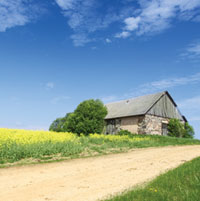 In the February 2004 issue of The Instrumentalist I chronicled my travails in learning how to drive a school bus. Although the process was traumatic, I have since found that the ability to drive a school bus has enabled me to schedule numerous shorter trips without the hassle of finding (and paying) a driver. However, I have absolutely refused to drive when my mind is more likely to be on band matters than the driving or when I know that the destination is a difficult place to navigate. I have also steadfastly refused to cover daily bus routes.
In the February 2004 issue of The Instrumentalist I chronicled my travails in learning how to drive a school bus. Although the process was traumatic, I have since found that the ability to drive a school bus has enabled me to schedule numerous shorter trips without the hassle of finding (and paying) a driver. However, I have absolutely refused to drive when my mind is more likely to be on band matters than the driving or when I know that the destination is a difficult place to navigate. I have also steadfastly refused to cover daily bus routes.
Driving a bus route is rarely an option because I have after-school practices most of the time. But a few weeks ago on the first day all year that I planned to go home right after the final bell, the junior high principal approached me.
“Two things,” he said. “First, that was a wonderful concert the other night. Everyone was talking about it.” Wary of what the second thing was, I hardly heard what he said. I got the feeling I was being buttered up like a jumbo box of popcorn. “And second,” he continued. “You know what I’m going to ask you, don’t you?”
“No, I don’t,” I said. And I didn’t.
“I need you to drive a bus route this afternoon.”
I had already told him the previous year that I was not comfortable with all the literal ins and outs of a bus route, and that I only had my license because I was forced to do it several years before. But as his story unfolded it became apparent that the educational system as we know it would fail if I did not sub on that route. He said he would ask four more people to drive but if they couldn’t do it, he needed me to drive. I reluctantly agreed. He’s lucky he’s a good principal who actually comes to band concerts or I wouldn’t have even considered it.
Unfortunately, no else could be found. To ease my concerns about the route he met me at bus number 14, a dusty veteran of daily ventures into the countryside. On the front seat he put a kid named Junior who was to be dropped off at one of the last stops. He would be my trusty guide. But there was one slight problem: How did I get back without a guide? (Did I mention that our predominantly rural district has about six different zip codes?) So I asked him about that.
“Haven’t you been to Griffithville before?” he asked.
“No.”
“How about Georgetown?”
“No.”
“Haven’t you eaten at Dondie’s in Des Arc? It’s a great restaurant.”
“No.”
Worried, I wondered what kind of route takes a bus through several towns.
“Do I just get back the way I came?” I asked.
“Yes.”
I would find out that was deceptively easy answer.
As I grabbed the bus controls, the students could sense that they had a rookie on their hands. “Do you have a license?” one asked.
“A license to kill,” I replied.
The kids laughed in the face of danger.
The trip started easily enough; out of 40 children, I dropped three-fourths of them off in the first 15 minutes. “This isn’t so hard,” I thought.
And in the understatement of the year, my trusty guide Junior said it would be a while before we stopped again. We passed by endless acres of fields, levees, silos, barns, and closed country stores. I frequently yelled, “Are we there yet?” over the grumbling of the engine. At some point we left the pavement and bounced onto a dirt road. I wish I had been aware of that sooner. Uninvited swirls of dust barged through and coated my face, mouth, and glasses. I spent the rest of the trip rubbing my eyes from particles that managed to bypass my lenses.
I managed to drop off all of the remaining kids (who all lived several miles apart) with only two mishaps. I backed into one ditch but managed to have enough engine power to pull the bus out, and I passed one stop when Junior was flirting with a girl impressed with his newfound responsibilities.
As the last child got off the bus and headed home I got the sense I may never see a human being again. I was all alone with almost no memory of how to get back. (And in my rush to leave I did not bring a cell phone.) On the way out I used as many memory crutches as I could, but I discovered that using silos and rusty barns was not a good idea because they all looked the same after a while. Once I got going, I felt like I was traveling through the set of Green Acres over and over again.
I was not, however, too proud to stop and ask directions. This afforded me the opportunity to meet some nice folks. Billy and Imogene Dunnum told me that if I kept going all I had to do was turn right at Chip’s Hill and get on Highway 385. After spending ten minutes trying to get out of their driveway I was on my way. (Most people are familiar with a three-point turn; I executed a perfect 18-point turn trying to avoid backing into another ditch.)
Let me state for the record that I never did make the acquaintance of Chip’s Hill or Highway 385. I somehow ended up on Bayou Road, which I assumed was so-named because it descended down into swampland – not unlike the Everglades. If I went off one of the narrow bridges I knew they wouldn’t find me for a month.
After several miles I made another house call. A kindly lady, Darcell Sellars, told me that if I took the next right, then another right at the pine grove, and then crossed the railroad tracks onto the pavement I would be on Highway 367, which would take me back to Searcy. Bless her heart, her directions were true, and when I hit that pavement, it was like the golden streets of heaven. Although I ended up several miles farther down the interstate than needed, I at least knew where I was.
As I pulled back into the school parking lot I calculated my time: 1 hour and 10 minutes to drop the kids off and 1 hour and five minutes to return. Two hours and 15 minutes I would never get back.
Disgusted, I parked the bus and pulled the key out only to have the confounded bus make a little buzz and then start honking over and over again. I ran to the back of the bus and pressed some button I was told would stop the honking if I turned the key just right. I put the key back in, turned it a little, then pulled it out again. Buzz. Honk, honk, honk. I went through this routine two times before the honking stopped. I’m not even sure what I did to make it stop besides make it clear to the bus that it would never so much as have a wiper blade left if it honked one more time.
It was a very frustrating experience but there was one upside. A few weeks later I took my wife (and a map) on a nice, long drive through the country to eat some great seafood at Dondie’s in Des Arc, the restaurant that my principal recommended. I actually thought I recognized a couple of the bus stops but gave up after a while. But I did notice that the countryside looks a lot better when the view is not from a bus, and the food tastes a lot better when there’s no sand in your mouth.






